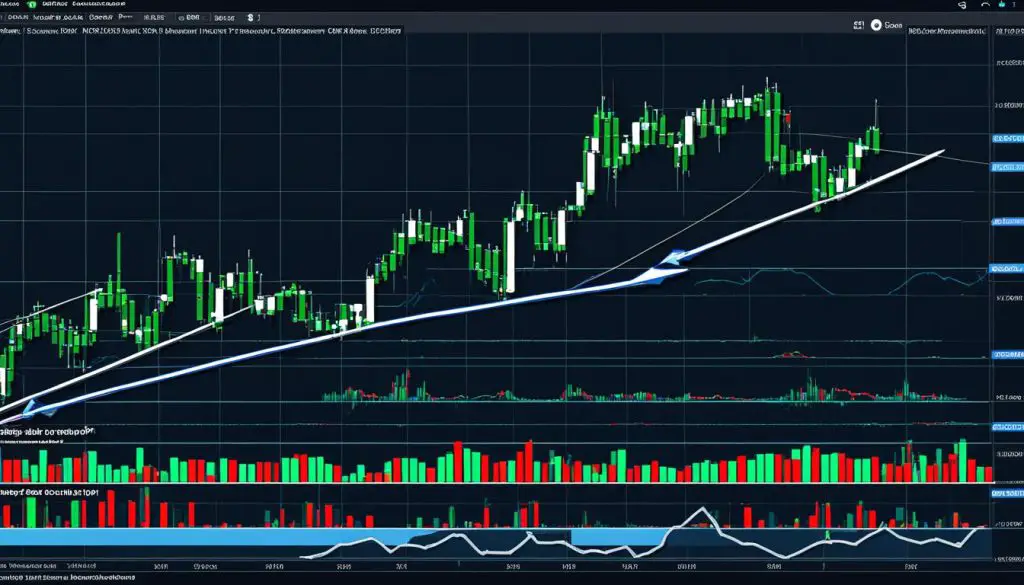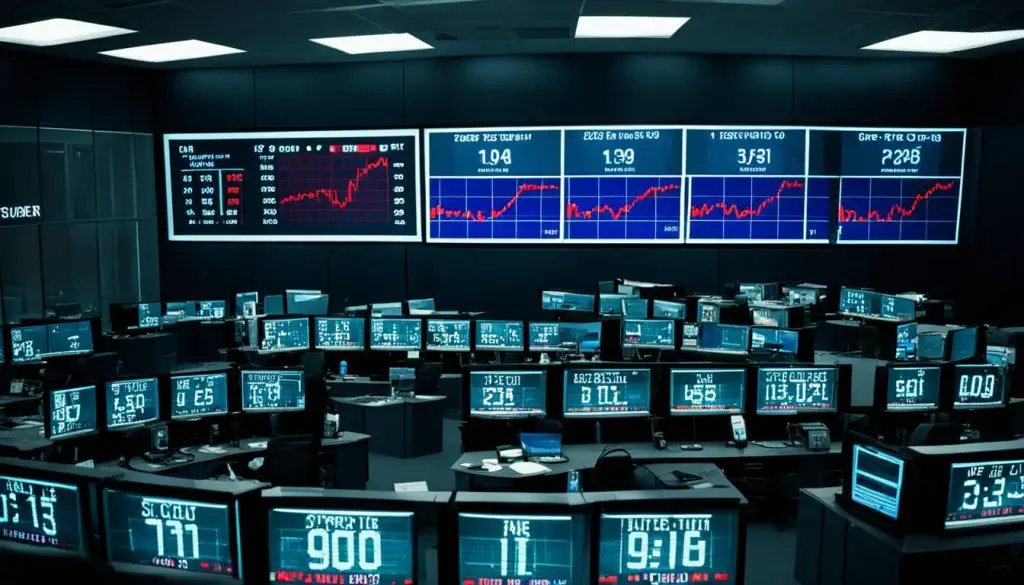In the world of forex trading, getting ahead often means studying order flow trading. This means understanding the flow of buy and sell orders. It helps traders know about trade volume and size in real-time. This is key to understanding what’s happening in the market right now. By looking at how orders move, traders can predict changes in prices. This knowledge helps them build better trading strategies.
Order flow is like the market’s pulse, showing the current buy and sell actions. This information is not just about numbers. It also tells about the market’s mood and the balance between what people want to buy or sell. With these insights, traders can understand the market better. It helps them get a grip on the details of futures trading and be more accurate.
Key Takeaways
- Order flow trading provides real-time trade volume and size data.
- Understanding order flow is essential for mastering futures trading.
- Order flow insights help in anticipating market movements.
- It reflects the current market sentiment by showing buy and sell pressures.
- Utilizing order flow can significantly enhance trading strategies.
Understanding the Basics of Order Flow Trading
Order flow trading studies buying and selling in the market. It gives traders a clear look into market dynamics by showing trade volume in real time. Traders use this to make smart decisions and stand out in the market analysis.
Definition and Concept of Order Flow
Order flow is the total of buy and sell orders in the market. It lets traders see the pressure from buyers and sellers, hinting at market moves. This live info is gold for those wanting to grasp market trends fast.
Importance of Order Flow in Market Analysis
Order flow shows the market’s supply and demand areas clearly. With the right tools, traders spot support and resistance levels easily. This helps in better market analysis, making trading decisions sharp and reducing risks.
Tools and Platforms for Order Flow Reading
Tools and trading platforms exist to aid in order flow analysis. Common tools are DOM interfaces and footprint charts. DOMs show pending orders at prices, while footprints detail volume, providing a close look at market actions.
| Tool | Description |
|---|---|
| Depth-of-Market (DOM) | Displays pending buy and sell orders at different price levels, helping traders identify areas of high liquidity. |
| Footprint Charts | Provides detailed volume information at each price level, enabling traders to see the exact amount of buying and selling activity. |
| Trading Software | Includes a range of tools for order flow trading, such as volume profiles and order book insights. |
Picking the right trading platform and tools matters for successful trading. It’s all about how functional, user-friendly, and dependable the chosen platforms are to boost trading skill.
Key Order Flow Strategies for Effective Trading
Traders who want to be ahead need to know order flow strategies well. This bit looks at how understanding volumes can boost your trading game. We’ll cover some tips to use volume and liquidity info to improve your trades.
Footprint Charts and Volume Analysis
Footprint charts are great for seeing volume analysis clearly. They show where buy and sell orders happen, giving a detailed look at trading. By checking these charts, traders spot areas with lots of activity, helping them decide better.
Market Depth and Liquidity Analysis
Market depth looks at the buy and sell orders within the order book. Liquidity analysis checks this depth. With this knowledge, traders can guess where prices might go next. This makes their trading plans stronger.
Smart Money Flow: Understanding Institutional Order Flow
Big players like banks and hedge funds are known as smart money. Knowing institutional order flow helps us see where the market’s going. These big traders have a lot of info and can move prices a lot.
Forex Order Flow: A Deep Dive into Currency Markets
Forex order flow shows all transactions in the global currency markets. Unlike futures, forex is decentralized. This makes it harder to track but deepens a trader’s understanding. It shows them the buying and selling pressures, helping to trade smarter.
Differences between Forex and Futures Order Flow
Futures trading happens on fixed exchanges, making it more regulated. But forex trades happen directly between traders, making it less clear. Traders look at tick volumes and market depth to understand the market better.
Techniques for Analyzing Forex Order Flow
To understand forex order flow, traders use special methods. Tick volumes show how active the market is and what traders feel. Watching the interbank market lets traders see big financial players’ orders. These tools help spot market trends.
Impact of Economic Events on Order Flow
Economic news can shake up the forex market. When central banks or countries change policies, traders react quickly. This can make the market very active. Political changes can also shift how traders value currencies. Knowing about these events can help traders make better decisions.
| Aspect | Forex Order Flow | Futures Order Flow |
|---|---|---|
| Market Structure | Decentralized | Centralized |
| Transparency | Lower | Higher |
| Primary Analysis Techniques | Tick Volume, Interbank Market Depth | Footprint Charts, DOM |
| Impact Factors | Economic Events, Geopolitical Developments | Market Sentiment, Liquidity |
Advanced Techniques and Tools for Order Flow Analysis
Getting into order flow analysis further means using advanced techniques and strong tools. One key method is the volume profile. It shows trading activity in a period as a graph.
Using Volume Profile for Enhanced Market Insights
The volume profile helps traders spot where the most trading happens at different prices. This insight is key. It shows important support and resistance levels. This makes decision-making smarter. Knowing the volume profile can help traders better guess market moves. It helps them make more accurate trades.
Best Practices for Interpreting Footprint Charts
Footprint charts give a close look at market activity on each price level. By studying these charts, traders can tell if buying or selling is strong. They also understand price and volume movements better. To read these charts well, focus on areas with lots of trading. These spots might signal big market interest and turning points.
Software and Trading Platforms for Order Flow Trading
Having top-notch trading software and platforms is crucial for order flow trading. It should have real-time updates, advanced charts, and custom options. Tools like NinjaTrader, Sierra Chart, and TradingView are great for this. They provide the tools needed for sophisticated order flow analysis. This helps traders make better trading choices.
Conclusion
Order flow trading is crucial for anyone looking to master the market. It involves understanding the fine details like market depth and liquidity. This helps traders make better decisions by using tools like footprint charts and volume profiles.
Improving your approach to order flow is key. Learning how institutional trades and economic events affect markets adds depth. This knowledge helps traders better understand market dynamics. Thus, they can navigate through tough trading environments.
The journey to becoming a trading expert is about always learning and adapting. Using advanced techniques and software keeps you ahead. This approach not only improves your skills but also helps you seize market chances more effectively.
FAQ
What is order flow trading?
Order flow trading is a way to look at trade data in real-time. It shows market supply and demand as trade volume and size. This method gives traders an advantage by letting them see what’s actually happening in the market.
Why is order flow important in market analysis?
Understanding order flow is key because it uncovers where buying and selling pressures exist. Traders use this info to predict price moves and spot trends. It helps them make smart choices in trading.
What tools and platforms are commonly used for order flow reading?
There are many tools to read order flow. Some common ones are trading software with depth-of-market features, footprint charts, and order flow indicators. These tools make it easier to understand order flow visually and analytically.
How can footprint charts and volume analysis enhance trading strategies?
Footprint charts and volume analysis are great for traders. Footprint charts show volume at each price level, pinpointing support and resistance areas. Volume analysis reveals market activity, helping find important price levels and possible reversals.
What is the significance of market depth and liquidity analysis?
Market depth and liquidity analysis look at the order book to find supply and demand levels. This helps traders comprehend market liquidity at various prices. Knowing this is vital for making big trades without moving the market too much.
What is smart money flow and how does it relate to institutional order flow?
Smart money flow is the trading done by big, knowledgeable investors. This includes institutional investors who have a lot of information and influence. Watching their moves can offer clues to where the market might go next because of their big trades and advanced tools.
What are the differences between forex and futures order flow?
Forex order flow is unique because the market isn’t centralized and has less oversight. To understand it, traders use tick volume analysis and look at the interbank’s depth. Futures order flow, however, is based on volume data from specific exchanges.
How do economic events impact forex order flow?
Economic events have a big impact on forex trading by changing the supply and demand quickly and intensely. Examples include central bank news. To stay ahead, traders need to keep an eye on economic calendars during these events.
How can volume profile be used for enhanced market insights?
Volume profile shows trading volume at different price levels over time. This method highlights areas of high activity, balance, and potential breakouts. It makes market insights clearer for traders, improving their decision-making.
What are the best practices for interpreting footprint charts?
To read footprint charts well, pay attention to volume at key price levels. Look for patterns in buying and selling. It’s also helpful to use them with other analysis tools and to get good at reading them fast and accurately.
What features should traders look for in order flow trading software and platforms?
When choosing order flow software, look for those that provide real-time data and have depth-of-market interfaces, footprint charts, and strong analytical tools. Customizable indicators, advanced charts, and a user-friendly design are also important for a good trading experience.






